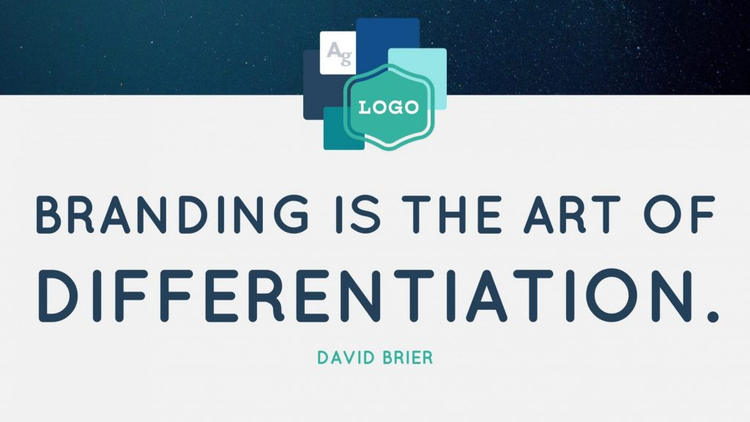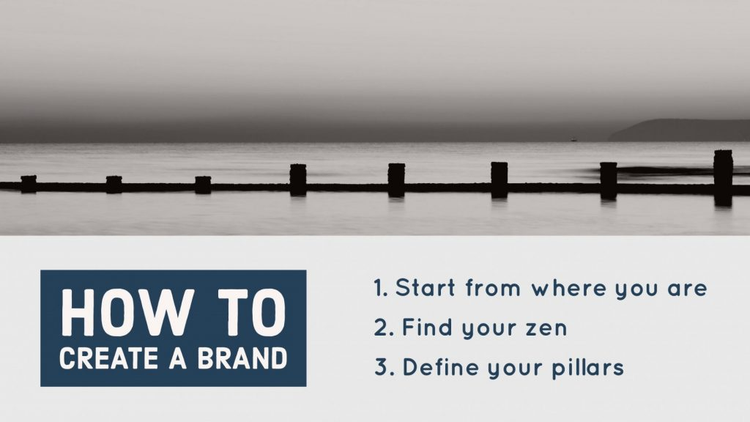What’s in a Brand: A Step-by-Step Guide to Defining a Winning Online Identity

“There are currently over 8,000 books available on Amazon about branding,” shares branding strategist David Brier. “That many opinions means something is being overlooked or people are collectively not understanding.”
To clear up the confusion, we spoke to Brier, founder of Rising Above the Noise, as well as Leonard Kim of Influence Tree and Ben Matthews, Adobe Spark’s Director of Design, to break down the answer to the question, “What is a brand?”
You’re in good hands with these three. Kim is recognized by Forbes, Inc., and Entrepreneur as a Top Marketing Influencer, and Brier is ranked No. 3 worldwide on Klout for branding, among other accolades. Meanwhile, Matthews has helped shape Adobe’s new content creation and branding experience, which seeks to demystify content marketing and branding.
Here, the industry vets go beyond color, type, and logo to discuss the self-discovery and outward exploration required to create a good brand that stands out. Read on to learn how to find your brand’s zen and define its purpose and pillars. With a clear brand strategy, you can either rebuild a vague brand into something powerful or develop one from scratch for your business, cause, or personal empire.
What Is a Brand?
“Branding is the art of differentiation,” Brier says. “Branding is the way that consumers identify and experience a product, service, or person, from the look, taste, feel, and sound—a brand is all of those multifaceted parts.”
Consider Starbucks. Starbucks demonstrates that a brand is so much more than their mermaid logo and the color palette, explains Brier. Every Starbucks has similar decor and music—that’s part of the brand. The taste and smell of the coffee is consistent around the world—that’s part of the brand. The setup of the menu and the barista uniforms are always the same—that’s part of the brand. The cup you carry on your way out, the continuity in each customer experience—that’s the Starbucks brand.
The beauty of branding is that with it comes trust and customer loyalty. People love Starbucks. They know what to expect and they know what they’ll get just by hearing the brand name. You associate an entire brand experience with the idea of Starbucks, and that’s what you’d like your brand to do for you.

The Starbucks brand may begin with a visual identity, which includes key elements like brand colors, fonts, and a logo. But it’s a successful brand because the experience is more than surface-deep. To maintain the company’s brand, the team behind Starbucks commits to a distinct brand voice, makes sure customers see a consistent brand image, and always stays true to its brand promise—which reflects its mission statement and value proposition.
So say you’re not Starbucks and you’re starting from scratch. It might seem overwhelming to create a brand identity from nothing. But the benefits of a clear point of view are well worth the self-discovery and market research required to find and fill your space in the world.
Why You Need a Strong Brand
A brand isn’t just a thing companies have. It also gives customers a reason to choose you and enact their brand loyalty. A brand, explains Brier, helps your target audience differentiate between you and the other guys.
“The art of differentiation is why we choose cars, shoes, whatever we buy,” shares Brier. “Take two identical bottles of water from two different brands. They’re basically the same product. Unable to find a real difference in the two, the customer will finally default to price. People need something to differentiate in order to make a choice. But say your water has minerals, or a special source, or pH magic, then you’re giving people a reason to choose you.”
Your brand can help you stand out among your competitors, even if your specific products or services aren’t too different.
Now you know you need to give people a reason to choose you, but how do you identify what makes you special and how you can convey that?

Market Research
Before you dive into building your own brand, understand the industry you’re entering and where you belong in it. This requires market research and some internal exploration.
You may want to disrupt the existing industry with a completely new product or service, or you may want to identify how you can position your relatively similar offering as unique.
When it comes to starting this, don’t be scared! We’ll provide a roadmap. But first, look at what savvy market research did for the Dyson vacuum company and how they turned the industry on its head.
Before Dyson, the vacuum industry was boring, states Brier. There wasn’t a hole in the market and there were plenty of vacuums that worked just fine, but people weren’t excited about buying a vacuum.
Then, Dyson came along with a new, intelligent design (a clear body where you saw the action taking place), new turbine technology, and colors that had never been used before (like Steve Jobs did with the iMacs and even some iPhones). Even if you had a vacuum, you wanted a Dyson.
That’s what a great idea can do when executed well. Ready to find your space in your target market?
Start with external competitive and visual audits.
A competitive audit analyzes the market to discover where the product or service you offer will fit in. Brier recommends you ask yourself:
- Is anyone already solving the problem I aim to solve with my product or service? If they are—are they solving it well or poorly?
- How crowded is the space? Define your top competitors.
- How can I differentiate my product or service?
A visual audit analyzes what your competitors look like, explains Brier. A well-done visual audit gives you the opportunity to be different in a relevant, meaningful way while still being sensitive to the pain point you’re eliminating. Ask yourself: How do my competitors look and feel? What’s their brand’s personality?
Often, players in a given industry have similar voices, looks, and feels, which gives you a chance to use your branding strategy to shine.
Apple nailed this differentiation with their iPod debut. They were the third MP3 player on the scene (not the first!), but they took over with their great tagline, “1,000 songs in your pocket,” great design, and catchy iPod name.
Create Audience Personas
The most important market and external research you can do is to figure out exactly who your target consumer is, says Kim, and then create audience personas for them.
An audience persona is best created from existing data, but if you don’t have a data set to use, envision the kind of person who would buy your product and become a loyal customer.
Here are some of Kim’s questions for nailing down your audience personas:
- How old are they?
- Are they male or female?
- What do they do for fun?
- What kind of car do they drive?
- What grocery store do they shop at?
- What do they eat for lunch?
- What kind of lifestyle do they have?
- Do they like reading or do they prefer drinking or are they more into outdoor activities?
- What social media platforms do they use?
- Are they single or in a relationship?
Create four different audience personas for your business and give each a name and picture. These personas will help you determine what brand attributes you need to incorporate to stand out from the crowd and appeal to your audience.
Understanding your audience personas will help you determine the language and tone, color palette, design aesthetic, and packaging that will draw those personas in.
Turn It Inward for an Internal Audit
Once you’ve gathered information on the market and audience personas, it’s time to turn the questioning inward. Ben Matthews, Director of Design at Adobe Spark, recommends a light framework to stay focused on your brand’s mission while researching your developing identity.
When you’re in a state of discovery, it’s easy to lose track of your brand’s core identity in favor of the latest shiny design aesthetic or a trendy marketing strategy. To stay true to your mission statement as a brand manager, take the following steps:
- Write down the aspirational vision of your business or brand.
- From your vision, extract your mission—the outcomes you hope to achieve.
- From your mission, define your values. What values are important to communicate to yourself and/or your employees?
- Consider how you want to communicate these internal values to potential customers.
“When you create your core values as a brand,” states Matthews, “it ensures consistency. Expectations are set with the business and customer which builds trust and awareness of what is offered from the brand.”
Now that you’re clear on what your brand stands for, your internal audit will be that much stronger. To begin the process, Kim recommends asking yourself:
- What other brands out there do I want to be like and how can I incorporate what they do well?
- What are my strengths and weaknesses?
- How does the world currently see me and how do I want to be seen?
- What makes my brand unique?
- What can I do to draw in attention?
Now you know what your external competitors are doing and what your internal framework is like. You also have the perfect foundation to achieve brand awareness at every customer touch point and soon, greater brand loyalty.

Is a Personal Brand Any Different?
You’re building a business brand, but your business is you. Is the process any different?
Use the same processes outlined above for creating your personal brand, Kim recommends.
“But instead of asking yourself how you want to be seen by the world, work on eliminating your flaws and highlighting your personality and what makes you unique,” Kim says.
Personal branding goes back to the bottom line of all branding, shares Brier. How do you differentiate?
“Internet personality Gary Vaynerchuk would not be noticeable if he did not drop f-bombs all the time,” Brier says. “Some personalities are driven by fashion, or a contrarian viewpoint—they appeal to the rebel, some personalities are really smart and safe. The entire Food Network is built on personal brands. As opposed to your product being an incredible lotion, it is now a person. Ask yourself, am I rebellious, stoic, etc. and then build your brand identity around that.”
People buy into others that they like, and they determine who they like through similar interests, explains Kim.
“If the person who is reading your content is saying ‘me too,’ then you have a strong and powerful brand that relates to others,” says Kim.
You can establish that public persona by following the road maps above.
Next Steps: Explore Prompts To Fuel Your Exploration
You’ve identified the product or service you’ll provide, where it fits in the existing industry, and who it appeals to. The next step is to enhance brand awareness with consistent designs and outward-facing copy.
While your brand may not be as widely recognized as Nike, Coca-Cola, or Google right away, staying true to who you are in all your marketing activities is the best way to get there in the future. To take the first step toward greater brand success, explore how to find your visual voice in order to stand out.
More branding help:
5 Creative Ideas for Logos You Can Create Now
3 Easy Steps to Picking Your Brand Colors
How to Create Branded Content with Adobe Spark